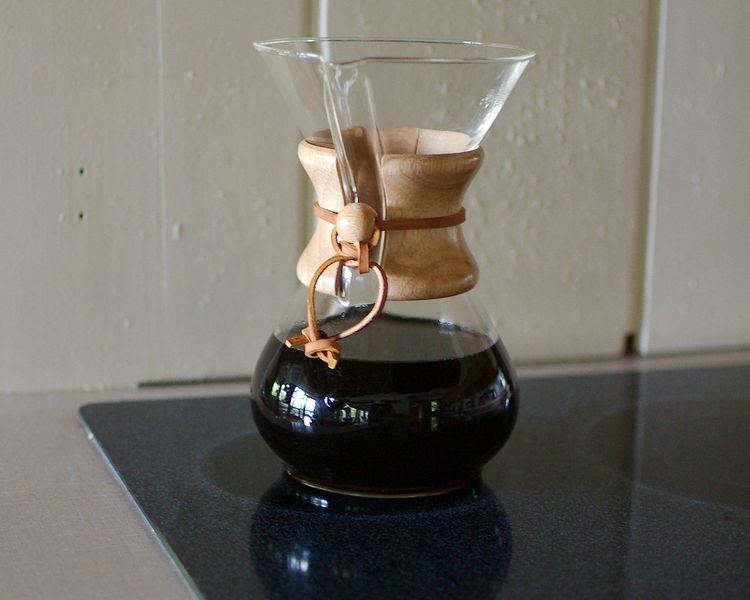 | ||
The Chemex Coffeemaker is a manual, pour-over style glass-container coffeemaker that Peter Schlumbohm invented in 1941, and which continues to be manufactured by the Chemex Corporation in Chicopee, Massachusetts.
Contents
In 1958, designers at the Illinois Institute of Technology said that the Chemex Coffeemaker is "one of the best-designed products of modern times", and so is included in the collection of the Museum of Modern Art in New York City.
Design
The Chemex Coffeemaker consists of an hourglass-shaped glass flask with a conical funnel-like neck (rather than the cylindrical neck of an Erlenmeyer flask) and uses proprietary filters, made of bonded paper (thicker-gauge paper than the standard paper filters for a drip-method coffeemaker) that removes most of the coffee oils, brewing coffee with a taste that is different than coffee brewed in other coffee-making systems; also, the thicker paper of the Chemex coffee filters may assist in removing cafestol, a cholesterol-containing compound found in coffee oils.
The most visually distinctive feature of the Chemex is the heatproof wooden collar around the neck, allowing it to be handled and poured when full of hot water. This is turned, then split in two to allow it to fit around the glass neck. The two pieces are held loosely in place by a tied leather thong. The pieces are not tied tightly and can still move slightly, retained by the shape of the conical glass. For a design piece that became popular post-war at a time of Modernism and precision manufacture, this juxtaposition of natural wood and the organic nature of a hand-tied knot with the laboratory nature of glassware was a distinctive feature of its appearance.
Brewing coffee
Coffee is brewed by first placing the paper filter and the ground coffee in the neck of the flask, while heating water to 82-93 °C in a separate vessel; then "blooming" (moistening) the ground coffee by pouring some hot water onto the dry coffee, and finally, by pouring the desired quantity of water (number of cups) over the ground coffee, and awaiting it to percolate down, through the coffee and the paper filter, into the flask.
In popular culture
In the 1954 romance movie Sabrina, a Chemex Coffeemaker can be seen in the corner of Linus's bar in his office. In spy literature, film, and television, the Chemex coffeemaker has appeared in the novel From Russia, with Love (1957), by Ian Fleming, who describes James Bond, when in London, brewing his breakfast coffee with a Chemex, using coffee bought from the De Bry's shop in New Oxford Street.
Chemex Coffeemakers can be seen in the kitchens of Rosemary and Guy Woodshouse in 1968's Rosemary's Baby, and Michael in the 1970 film The Boys in the Band.
In the television comedy programme The Mary Tyler Moore Show (1970–77), the Mary Richards (Mary Tyler Moore) character has such a coffeemaker in the kitchen of her apartment. Similarly, a Chemex can be spotted on the stovetop in the pilot of Friends (1994)
A Chemex can be seen in Don Draper's kitchen in the AMC show Mad Men (2007–15).
A Chemex can also be seen in the German movie Vor der Morgenröte, a biographic picture about Stefan Zweig.
A Chemex is seen in the Roman Polanski film Rosemary's Baby and is used by Dustin Hoffman's character in the breakfast scene of John and Mary, which also stars Mia Farrow.
In Christopher Nolan's film Interstellar a Chemex is used as a water pitcher.
